Clicker Training Accelerates Learning of Complex Behaviors but Reduces Discriminative Abilities of Yucatan Miniature Pigs
Simple Summary
Abstract
1. Introduction
2. Materials and Methods
2.1. Animals
2.2. Groups
2.3. Apparatus
2.4. Objects
2.5. Training to Fetch (Steps and Criterion)
2.6. Discriminative Test
2.7. Analyses
3. Results
4. Discussion
4.1. Clicker for Complex Behaviors
4.2. Clicker Training Hypothesis
4.3. Discrimination
4.4. Pig Cognition
5. Conclusions
Author Contributions
Funding
Conflicts of Interest
References
- Pryor, K. Getting Started: Clicker Training for Dogs; Sunshine Books: Waltham, MA, USA, 2002. [Google Scholar]
- Skinner, B.F. The Behavior of Organisms: An Experimental Analysis; Appleton-Century: Oxford, UK, 1938. [Google Scholar]
- Skinner, B.F. How to teach animals. Sci. Am. 1951, 185, 26–29. [Google Scholar] [CrossRef]
- Lattal, K.A. Delayed reinforcement of operant behavior. J. Exp. Anal. Behav. 2010, 93, 129–139. [Google Scholar] [CrossRef] [PubMed]
- Grice, G.R. The relation of secondary reinforcement to delayed reward in visual discrimination learning. J. Exp. Psychol. 1948, 38, 1–16. [Google Scholar] [CrossRef] [PubMed]
- Chiandetti, C.A.; Fongaroa, E.; Cerrib, F. Can clicker training facilitate conditioning in dogs? Appl. Anim. Behav. Sci. 2016, 108, 109–116. [Google Scholar] [CrossRef]
- Pryor, K. Reaching the Animal Mind: Clicker Training and what it Teaches us. In About All Animals; Scribner: New York, NY, USA, 2009. [Google Scholar]
- Pryor, K. Don’t Shoot the Dog! The New Art of Teaching and Training; B. Books: New York, NY, USA, 1999. [Google Scholar]
- Ramirez, K. Animal Training: Successful Animal Management Through Positive Reinforcement; Shedd Aquarium Society: Chicago, IL, USA, 1999. [Google Scholar]
- Lindsay, S.R. Handbook of Applied Dog Behavior and Training; I.S. Univ and Press: Ames, IA, USA, 2000. [Google Scholar]
- Feng, L.C.; Howell, T.J.; Bennett, P.C. Practices and perceptions of clicker use in dog training: A survey-based investigation of dog owners and industry professionals. J. Vet. Behave. 2018, 23, 1–9. [Google Scholar] [CrossRef]
- Feng, L.C.; Howell, T.J.; Bennett, P.C. Comparing trainers’ reports of clicker use to the use of clickers in applied research studies: Methodological differences may explain conflicting results. Pet Behav. Sci. 2017, 3, 1–18. [Google Scholar] [CrossRef]
- McCall, C.A.; Burgin, S.E. Equine utilization of secondary reinforcement during response extinction and acquisition. Appl. Anim. Behav. Sci. 2002, 7, 253–262. [Google Scholar] [CrossRef]
- Williams, J.L.; Friend, T.H.; Nevill, C.H.; Archer, G. The efficacy of a secondary reinforcer (clicker) during acquisition and extinction of an operant task in horses. Appl. Anim. Behav. Sci. 2004, 88, 331–341. [Google Scholar] [CrossRef]
- Smith, S.M.; Davis, E.S. Clicker increases resistance to extinction but does not decrease training time of a simple operant task in domestic dogs (Canis familiaris). Appl. Anim. Behav. Sci. 2008, 110, 318–329. [Google Scholar] [CrossRef]
- Willson, E.K.; Stratton, R.B.; Bolwell, C.F.; Stafford, K.J. Comparison of positive reinforcement training in cats: A pilot study. J. Vet. Behav. Clin. Appl. Res. 2017, 21, 64–70. [Google Scholar] [CrossRef]
- Langbein, J.; Siebert, K.; Nürnberg, G.; Manteuffel, G. Learning to learn during visual discrimination in group housed dwarf goats (Capra hircus). J. Comp. Psychol. 2007, 121, 447–456. [Google Scholar] [CrossRef] [PubMed]
- Simon-Thomas, E.R. The voice conveys specific emotions: Evidence from vocal burst displays. Emotion 2009, 9, 838–846. [Google Scholar] [CrossRef] [PubMed]
- Wood, L. Clicker Bridging Stimulus Efficacy. K.P.C. Training, Unpublished Work. 2008. [Google Scholar]
- Council, N.R. Nutrient Requirements of Swine, 11th ed.; T.N.A. Press: Washington, DC, USA, 2012. [Google Scholar]
- Gillis, T.E.; Janes, A.C.; Kaufman, M.J. Positive reinforcement training in squirrel monkeys using clicker training. Am. J. Primatol. 2012, 74, 712–720. [Google Scholar] [CrossRef] [PubMed]
- Feng, L.C.; Hodgens, N.H.; Woodhead, J.K.; Howell, T.J.; Bennett, P.C. Is clicker training (Clicker + food) better than food-only training for novice companion dogs and their owners? Appl. Anim. Behav. Sci. 2018, 204, 81–93. [Google Scholar] [CrossRef]
- Feng, L.C.; Howell, T.J.; Bennett, P.C. How clicker training works: Comparing reinforcing, marking, and bridging hypotheses. Appl. Anim. Behav. Sci. 2016, 181, 34–40. [Google Scholar] [CrossRef]
- Williams, B.A. Conditioned reinforcement: Experimental and theoretical issues. Behav. Anal. 1994, 17, 261–285. [Google Scholar] [CrossRef]
- Lubow, R.E.; Moore, A.U. Latent inhibition: The effect of nonreinforced pre-exposure to the conditional stimulus. J. Comp. Physiol. Psychol. 1959, 52, 415–419. [Google Scholar] [CrossRef]
- Kehoe, E.J. Discrimination and generalization. In Learning Theory and Behavior; Menzel, R., Ed.; Elsevier: Oxford, UK, 2008; pp. 123–150. [Google Scholar]
- Schluessel, V.G.; Fricke, H.; Bleckmann, H. Visual discrimination and object categorization in the cichlid Pseudotropheus sp. Anim. Cogn. 2012, 15, 525–537. [Google Scholar] [CrossRef]
- Koban, A.; Cook, R. Rotational object discrimination by pigeons. J. Exp. Psychol. Anim. Behav. Process. 2009, 35, 250–265. [Google Scholar] [CrossRef]
- Hemsworth, P.H.; Coleman, G.J.; Cox, M.L.; Barnett, J.L. Stimulus generalization: The inability of pigs to discriminate between humans on the basis of their previous handling experience. Appl. Anim. Behav. Sci. 1994, 40, 129–142. [Google Scholar] [CrossRef]
- Tanida, H.; Nagano, Y. The ability of miniature pigs to discriminate between a stranger and their familiar handler. Appl. Anim. Behav. Sci. 1998, 56, 149–159. [Google Scholar] [CrossRef]
- Held, S.; Baumgartner, J.; Kilbride, A.; Byrne, R.W.; Mendl, M. Foraging behaviour in domestic pigs (Sus scrofa): Remembering and prioritizing food sites of different value. Anim. Cogn. 2005, 8, 114–121. [Google Scholar] [CrossRef] [PubMed]
- Aust, U.; Range, F.; Steurer, M.; Huber, L. Inferential reasoning by exclusion in pigeons, dogs, and humans. Anim. Cogn. 2008, 11, 587–597. [Google Scholar] [CrossRef] [PubMed]
- Hill, A.E.; Collier-Baker, E.; Suddendorf, T. Inferential reasoning by exclusion in great apes, lesser apes, and spider monkeys. J. Comp. Psychol. 2011, 125, 91–103. [Google Scholar] [CrossRef] [PubMed]
- Marsh, H.L.; Vining, A.Q.; Levendosky, E.K.; Judge, P.G. Inference by exclusion in lion-tailed macaques (Macaca silenus), a hamadryas baboon (Papio hamadryas), capuchins (Sapajus apella), and squirrel monkeys (Saimiri sciureus). J. Comp. Psychol. 2015, 129, 256–267. [Google Scholar] [CrossRef]
- Mikolasch, S.; Kotrschal, K.; Schloegl, C. African grey parrots (Psittacus erithacus) use inference by exclusion to find hidden food. Biol. Lett. 2011, 7, 875–877. [Google Scholar] [CrossRef]
- O’Hara, M.; Auersperg, A.M.I.; Bugnyar, T.; Huber, L. Inference by Exclusion in Goffin Cockatoos (Cacatua goffini). PLoS ONE 2015, 10, 0134894. [Google Scholar] [CrossRef]
- Subias, L.; Griffin, A.S.; Guez, D. Inference by exclusion in the red-tailed black cockatoo (Calyptorhynchus banksii). Integr. Zool. 2019, 14, 193–203. [Google Scholar] [CrossRef]
- Lind, N.M.; Moustgaard, A.; Jelsing, J.; Vajta, G.; Cumming, P.; Hansen, A.K. The use of pigs in neuroscience: Modeling brain disorders. Neurosci. Biobehav. Rev. 2007, 31, 728–751. [Google Scholar] [CrossRef]
- Vodicka, P.; Smetana, K.; Dvorankova, B.; Emerick, T.; Xu, Y.Z.; Ourednik, J.; Ourednik, V.; Motlik, J. The miniature pig as an animal model in biomedical research. Ann. N.Y. Acad. Sci. 2005, 1049, 161–171. [Google Scholar] [CrossRef]
- Mendl, M.; Held, S.; Byrne, R.W. Pig cognition. Curr. Biol. 2010, 20, 796–798. [Google Scholar] [CrossRef] [PubMed]
- Gieling, E.T.; Schuurman, T.; Nordquist, R.E.; van der Staay, F.J. The pig as a model animal for studying cognition and neurobehavioral disorders. Curr. Top. Behav. Neurosci. 2011, 7, 359–383. [Google Scholar] [PubMed]
- Wemelsfelder, F. Boredom and laboratory animal welfare. In A Survey of Scientific and Ethical Issues for Investigators: The Experimental Animal in Biomedical Research; Rollin, B.E., Kesel, M.L., Eds.; CRC Press: Boca Raton, FL, USA, 1990. [Google Scholar]
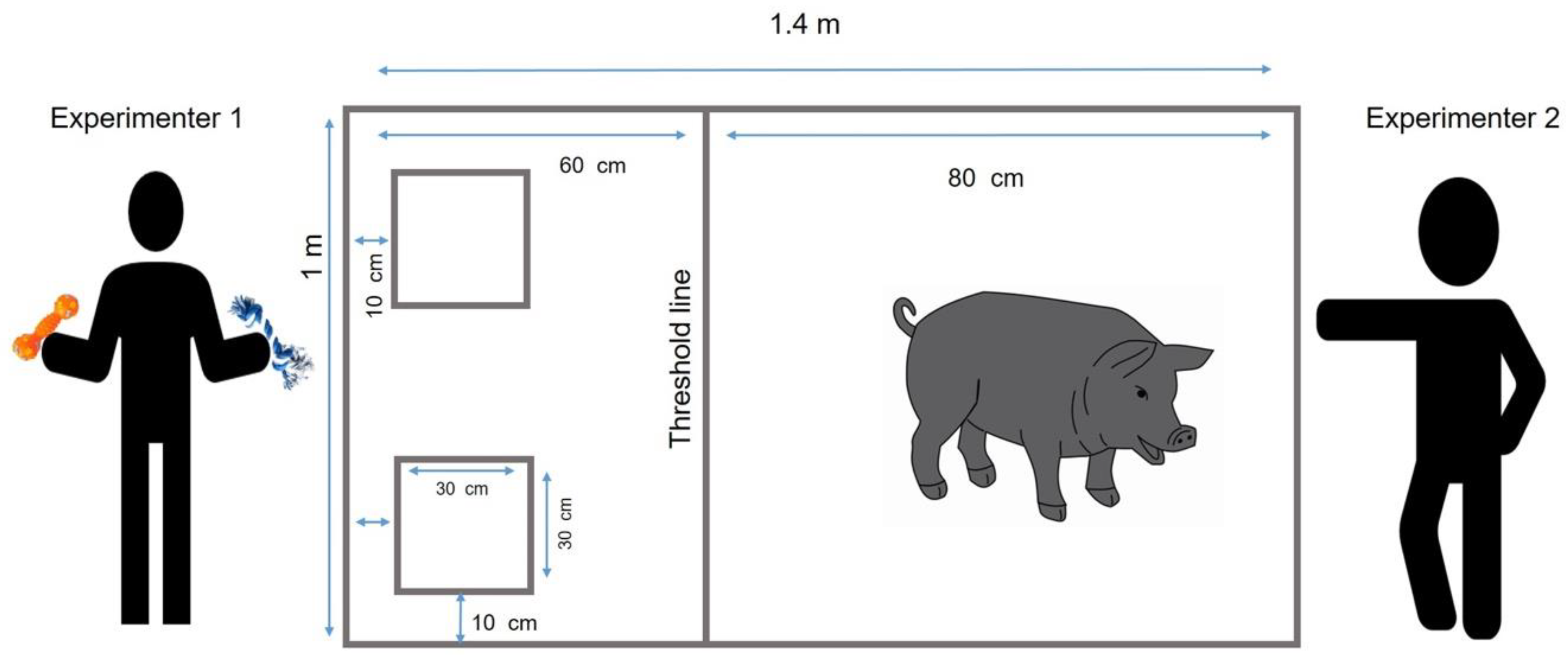
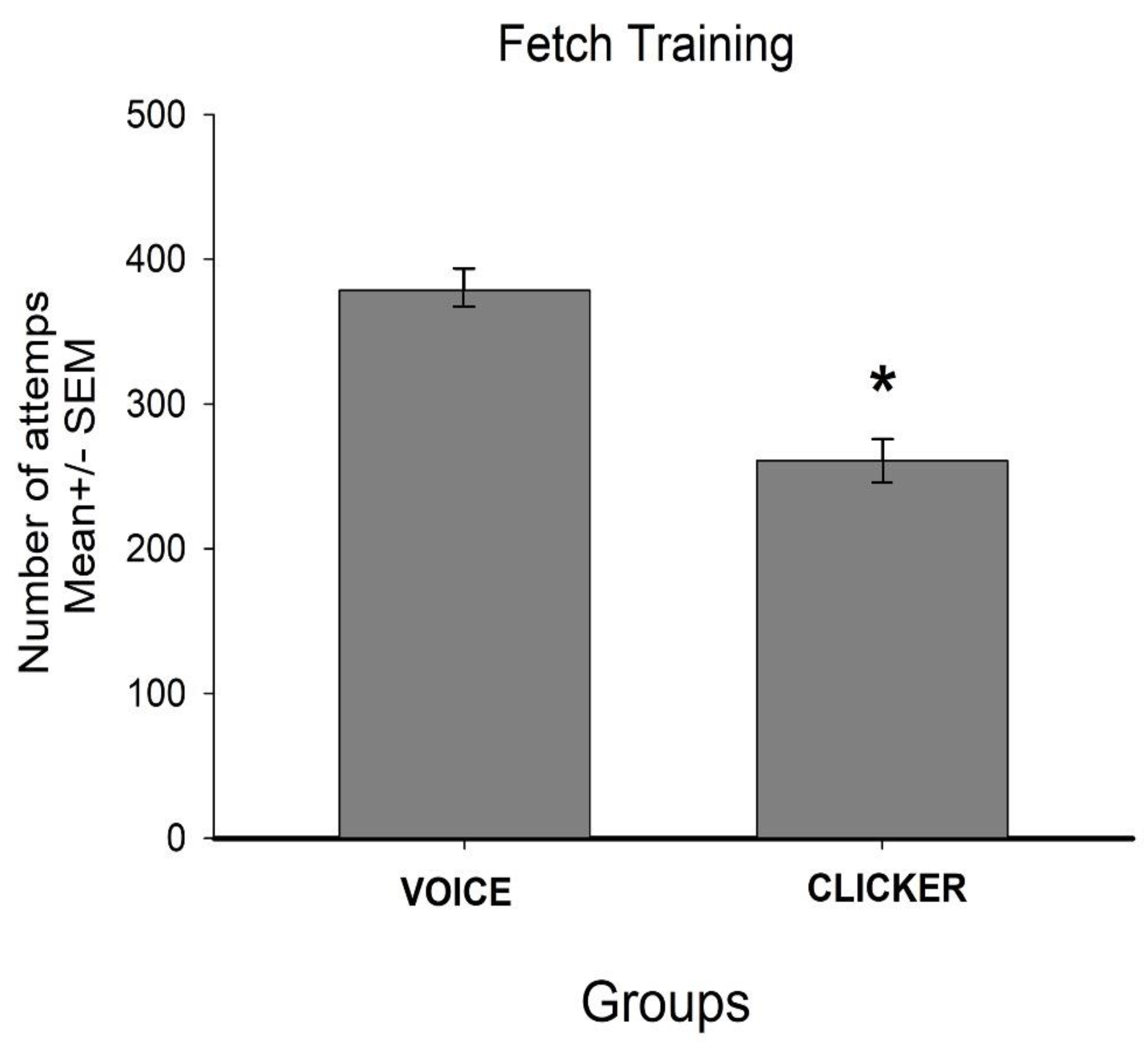
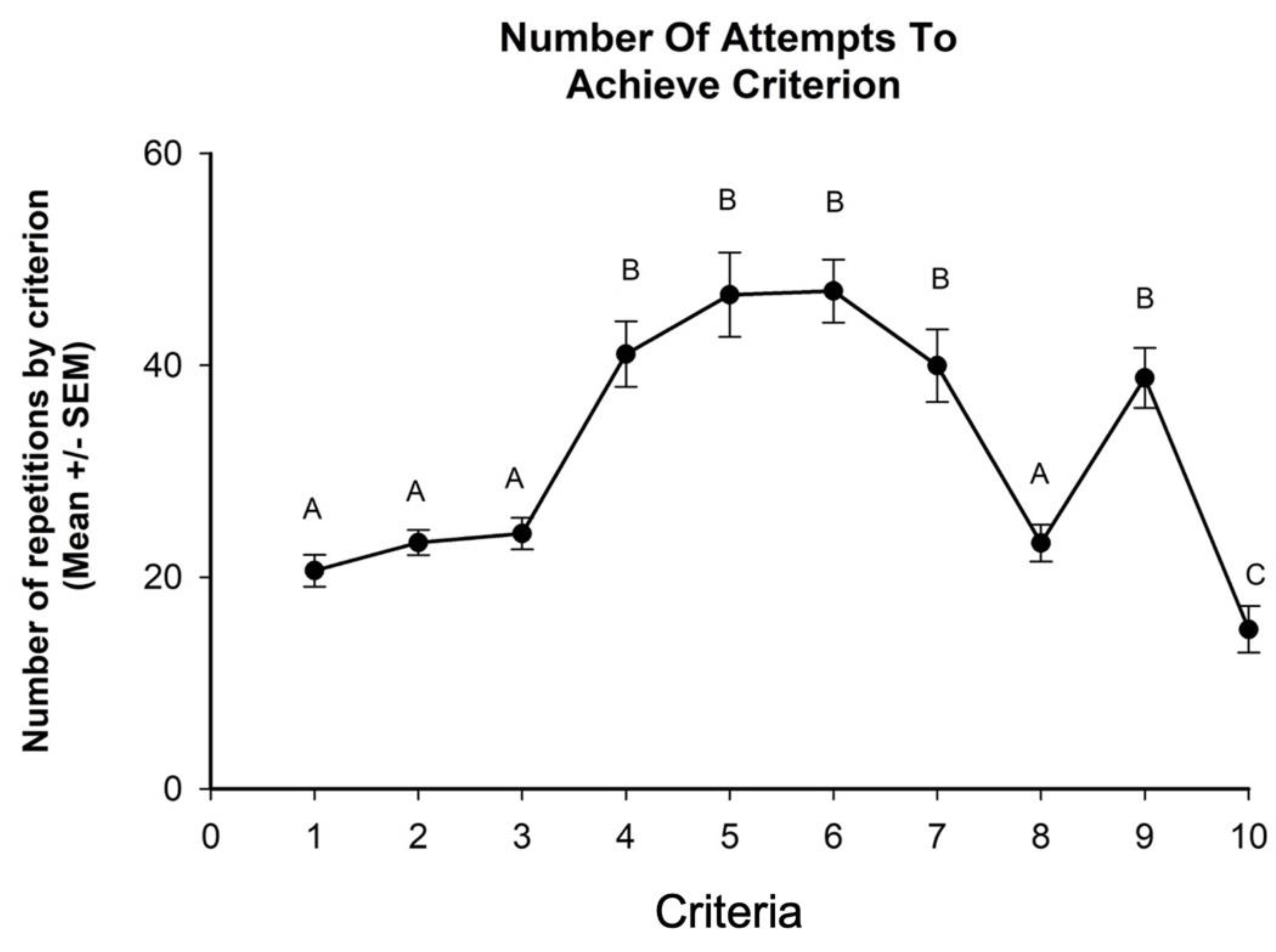
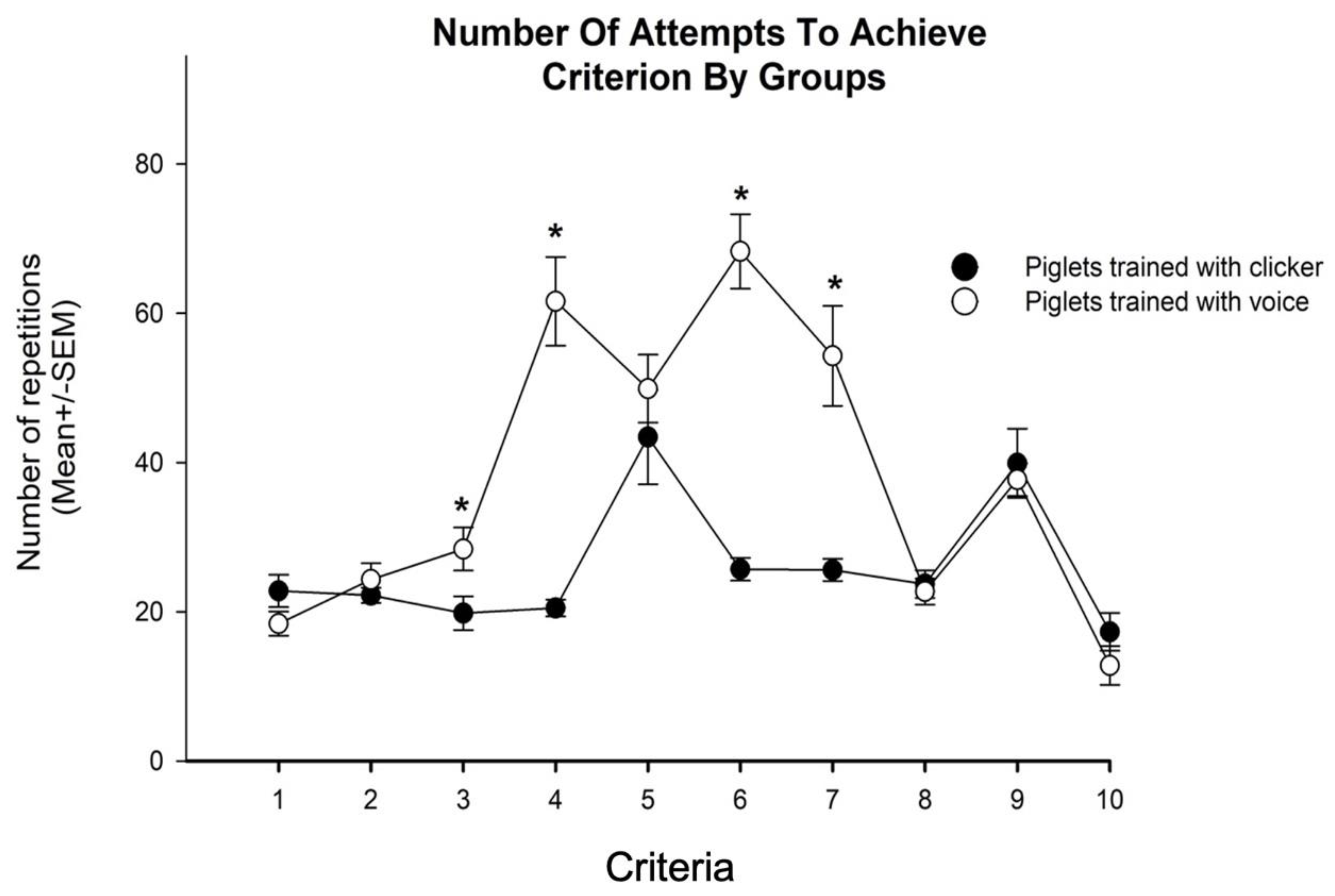
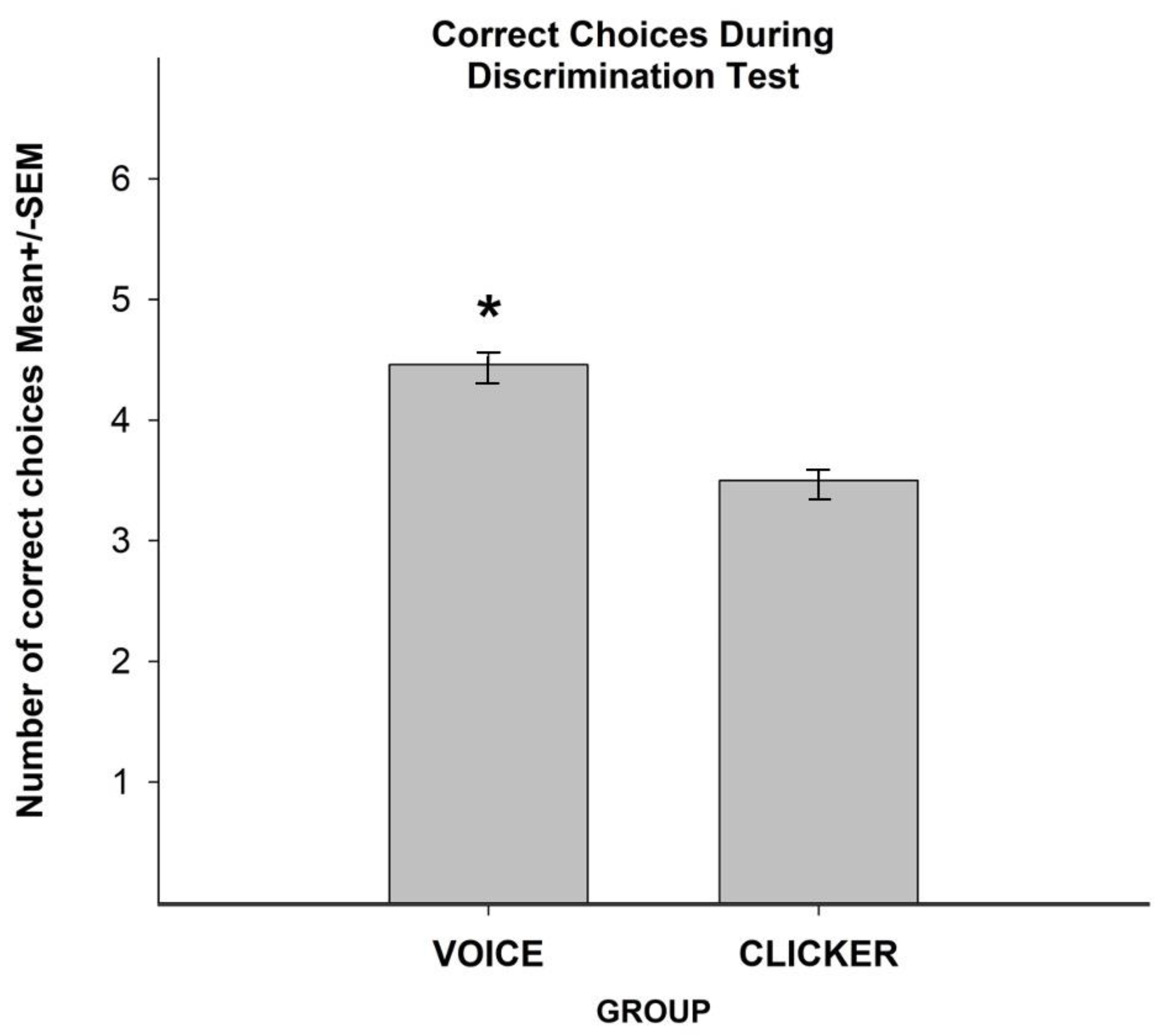
© 2020 by the authors. Licensee MDPI, Basel, Switzerland. This article is an open access article distributed under the terms and conditions of the Creative Commons Attribution (CC BY) license (http://creativecommons.org/licenses/by/4.0/).
Share and Cite
Paredes-Ramos, P.; Diaz-Morales, J.V.; Espinosa-Palencia, M.; Coria-Avila, G.A.; Carrasco-Garcia, A.A. Clicker Training Accelerates Learning of Complex Behaviors but Reduces Discriminative Abilities of Yucatan Miniature Pigs. Animals 2020, 10, 959. https://doi.org/10.3390/ani10060959
Paredes-Ramos P, Diaz-Morales JV, Espinosa-Palencia M, Coria-Avila GA, Carrasco-Garcia AA. Clicker Training Accelerates Learning of Complex Behaviors but Reduces Discriminative Abilities of Yucatan Miniature Pigs. Animals. 2020; 10(6):959. https://doi.org/10.3390/ani10060959
Chicago/Turabian StyleParedes-Ramos, Pedro, Joanna V. Diaz-Morales, Manuel Espinosa-Palencia, Genaro A. Coria-Avila, and Apolo A. Carrasco-Garcia. 2020. "Clicker Training Accelerates Learning of Complex Behaviors but Reduces Discriminative Abilities of Yucatan Miniature Pigs" Animals 10, no. 6: 959. https://doi.org/10.3390/ani10060959
APA StyleParedes-Ramos, P., Diaz-Morales, J. V., Espinosa-Palencia, M., Coria-Avila, G. A., & Carrasco-Garcia, A. A. (2020). Clicker Training Accelerates Learning of Complex Behaviors but Reduces Discriminative Abilities of Yucatan Miniature Pigs. Animals, 10(6), 959. https://doi.org/10.3390/ani10060959






